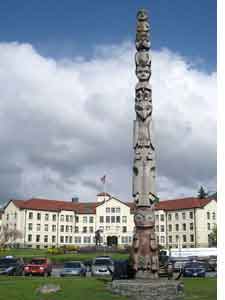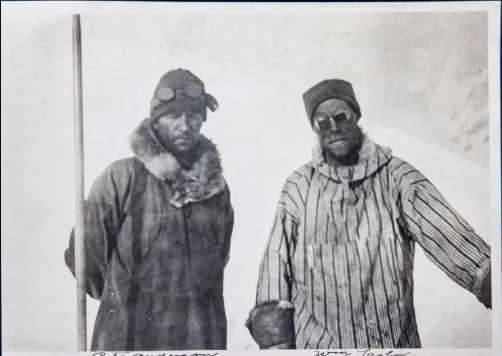Springtime was settling into the Matanuska Valley the evening Ronald Oquilluk went missing. The skies likely resonated with the cries of northbound geese, the sun climbing higher each day to brighten Pioneer Peak and Palmer’s weathered colony-era barns far below. That would have been the setting on April 29, 1987, when Oquilluk, a 38-year-old man with special needs, left his assisted living home near Butte at Mile 5 of the Old Glenn Highway never to be seen again.
Initially, Oquilluk’s disappearance was not considered unusual. He’d left the home on other occasions, slipping away from caregivers only to be found, soon enough, down the road a piece. On one particularly extended walkabout, he turned up in Anchorage 40 miles away.
This time, however, was different. Oquillik wasn’t located within a few hours or even a few days. This time weeks went by. And then months. Eventually, years stacked up with no trace found of the missing man.
What had become of Ronald Oquilluk? That question – along with the prayers of caregivers, family, and searchers that he be found – would go unanswered for 32 years.
Indeed, Ronald Oquilluk’s status would likely have remained unknown forever were it not for the fortuitous, if initially curious, discovery of human remains far away in Interior Alaska. Even then Oquilluk’s disappearance wouldn’t be resolved for years. But missing person cases remain open until they’re solved. And in this instance, answers would come with the help of advances in DNA technology; a family member’s persistence and cooperation; and the diligent work of Malia Miller, Missing Persons Clearinghouse manager for the Alaska State Troopers.
“On September 2, 1996, partial human remains were found in Central,” said Miller, meeting late last month in Anchorage with state troopers’ public information staff.
By “Central” Miller was referring not to a region, but to a community of fewer than 100 located along the Steese Highway in Interior Alaska. Some 122 miles northeast of Fairbanks, the tiny outpost with roots to Alaska’s gold mining past was 450 miles away from Oquilluk’s last known whereabouts nine years earlier. The remains were discovered in a dry creek bed and included a jawbone and some hair, Miller said. Little else was found.
Finding few clues and no traceable evidence, investigators were left to speculate. It was thought the remains might be those of a woman gone missing in the area in 1995. But that was just a theory. In 1996, there was no way to know for sure.
“We had no technology for DNA testing at the time,” said Miller.
So, for the immediate future, the remains went the way of all cold cases. They were packed and stored away carefully to rest with the anonymous bones of many other lost souls.
Reagan was President of the United States when Ronald Oquilluk went missing in 1987. Three presidents and 14 years later a new millennium brought changes that included significant advances in forensic science and technology. The age of DNA testing had dawned.
“In June 2001, we tried DNA testing,” Miller explained. “We sent the remains (found in Central) to the FBI.” With DNA technology still developing and forensic laboratories navigating backlogs, getting results would take time. So troopers waited. And finally, two years later, the FBI’s results came back. Unfortunately, the findings shed little light onto whom the remains belonged.
“In 2003 we were notified they had a DNA profile,” Miller said. “It ruled out the missing person we thought it might be.”
Compared against a family member of the woman who’d gone missing in the Fairbanks area in 1995, the profile was not a match. By eliminating that possibility, the information was somewhat helpful. But it fell far short of breaking the case.
[content id=”79272″]
So, the mystery of the human remains found in Central picked up where it left off. The whereabouts of Ronald Oquilluk, missing now for 16 years, would remain unknown for yet another 16 years.
Approximately 1,350 unsolved cases are currently housed in the Alaska State Trooper’s Missing Persons Clearinghouse. For now, those cases wait in a silent limbo.
To suggest it will take time to process that accumulation would be a gross understatement. Still, there is reason for optimism. The President’s Initiative to Advance Justice through DNA Technology, signed by President George W. Bush in 2003, directed an initial $232.6 million in federal money to fund the development of forensic DNA technology and reduce the backlog of unanalyzed DNA samples and biological evidence.
Specifically addressed in the initiative is the need to expedite through DNA the identification of missing persons: “Families of missing persons who are presumed dead face tremendous emotional turmoil when they are unable to learn about the fates of their loved ones.”
Word of the program came as good news to Miller. The federal funding would fuel her efforts to whittle down Alaska’s missing persons backlog. At the same time, the initiative provided new hope for relatives of missing persons. Family members could now play a critical, direct role in helping Miller find their missing loved ones. It’s as easy as having a law enforcement officer rub a DNA collection swab inside your cheek and submitting it to the Missing Persons Clearinghouse with the properly signed consent form.
In 2018, Alice Topkok did exactly that. Topkok was Oquilluk’s sister and she hadn’t given up hope that Ronald’s case might one day be resolved. When she called in to check on the status of her missing brother’s case – now more than 30 years after the fact – Topkok was invited to provide her DNA to match against samples gathered from remains entered into the Combined DNA Index System (CODIS).
Topkok provided her DNA on March 2, 2018, and, backed by funding from the President’s Initiative, Miller sent it off to a laboratory at the University of Northern Texas. There the sample would be added to a queue for processing and then placed in CODIS. This time, the results were returned in less than a year.
And they were mind-blowing. “The FBI notified the University of Texas on March 28, 2019, of a match,” said Miller.
Turns out the remains found near Central 23 years earlier were none other than those of Ronald Oquilluk. After 32 years, his missing status was resolved.
Miller’s face lights up at the memory. But only for a moment. Sadly, one final, tragic footnote to the story remained. Alice Topkok never got to hear the news she’d requested. On October 30, 2018, three months prior to the FBI’s announcement and after more than three decades of wondering and waiting for her long lost brother to come home, she died.
A niece was located in Fairbanks, however, and notified of the news about her uncle. And so, in that bittersweet way, one more missing person case was closed. But Miller has many more to solve. And with today’s DNA technology, it’s now possible to close cases much more expediently.
Still, Miller can’t do it alone.
“It doesn’t matter how long ago your loved one went missing,” she said. “With family DNA, we might be able to resolve a case decades old.”
Source: DPS






